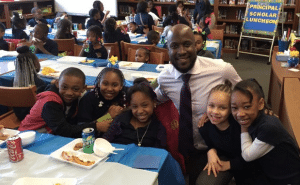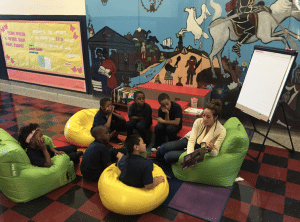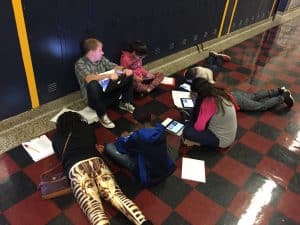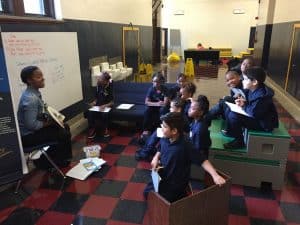Loving Learning at Lovett Elementary
CompetencyWorks Blog

This is the third post in a series covering my recent trip to Chicago. Begin with CBE in Chicago.
During my visit to Chicago, I joined a tour hosted by LEAP to Lovett Elementary School. It was a group tour, so I didn’t have the opportunity to dig in as deeply as I do with other school visits. Lovett is starting with personalized learning as their entry point. They have some of the things one would expect to see in a competency-based school but not all.
These are just a few highlights:
Lovett Elementary School vibrates with energy. Dr. LeViis Haney, principal of Lovett, explained, “A few years back, we came up with the tagline, ‘Love it at Lovett.’ The problem was the kids didn’t really love it at Lovett. So we asked ourselves, ‘How can we transform the environment so that kids really would love learning?’”
At the time, the school was very traditional, with thirty students “jammed” into classrooms with one teacher. Many of our students come “from down the hill,” referring to the income levels of the community. Nearly all students are on Free or Reduced Lunch. Many of our parents didn’t do well in school themselves and their opinions of schools and teachers were informed by their own less-than-positive experiences.
Haney described their previous top-down, compliance based-culture: “Everyone was doing what they were supposed to be doing. Teachers were teaching the curriculum and kids were listening and receiving knowledge. Students went from one worksheet or workbook to the next. The problem was that all the instruction was just one-way without consideration of students’ needs.” The results were manifold: a high percentage of disciplinary office referrals and high suspension rates; teachers were isolated and only felt responsibility for their classrooms; technology integration was almost nonexistent and didn’t come with teacher training; and there were low rates of parent satisfaction and high rates of student apathy.
Introducing Design Thinking
Dr. Haney, who has been principal at Lovett for five years, demonstrated his commitment to a new direction by cancelling the workbook order for the year. Teachers would have to find another way to engage students in learning. One of the important steps was site visits. Assistant Principal Latoya Lyons explained that “the best recipe to get staff on board with personalization is visits to other schools; otherwise, you (administration) have to sell it.” Once they see personalization in action they start to realize how to do it and what is possible.
Soon after this, Lovett teachers participated in the the Summer Design Program sponsored by the Chicago Public Education to learn to use design thinking to approach school improvement. (See video about Design Program.) Haney explained, “We were designing lots of different things, and through that process, we began to shift how we approached problem-solving.” The big problem facing Lovett (and the problem facing most of American schools) is, Why are kids not as successful as we want them to be and think they should be? The number one issue they identified is that there is little to no differentiation, even though students are all over the place in terms of their skills. Haney explained, “The problem is we needed to define what a successful student looks like. We asked ourselves, ‘If you had the perfect student, what would his/her disposition look like?’ The answer was motivated, engaged, and prepared for the next step.” They then moved on to the question, How might we rethink the way we provide instruction if we wanted to develop the perfect student?
This process led to the birth of a new vision: for students to love learning.
Our vision at Joseph Lovett Elementary School is for our students to Love it at Lovett: As a result of engaged, personalized instruction, coupled with strong school/family collaboration, our students leave us not only meeting or exceeding state academic standards, but also motivated, hungry, and excited about learning, with the skills, habits, and dispositions necessary for college and career success in the 21st century.
To achieve our vision, our mission at Joseph Lovett Elementary is to engage our students in a personalized learning environment that is learner led, learner focused, and learner paced. We will help students develop a lifetime love for learning in our technologically integrated, anytime-anywhere project-based learning curriculum, where students are in the driver’s seat of their own learning.
Lovett has used this vision as the foundation for a new, school-wide approach to learning. Lovett piloted changes to their model, along with edtech, through the LEAP Innovations Pilot Network, which works with school teams to test out innovation across specific grades and subject areas. In 2015, Lovett was selected for LEAP Innovations’ Breakthrough Schools program, which supports schools with $30,000 in planning funding, regular workshops, and access to experts as they design innovative models rooted in personalized learning for their entire school. Based on their strong blueprint for transformation, Lovett was one of just seven schools awarded an additional $280,000 and continued expert support for implementation. Lovett is now midway through their implementation year.
Design Anchors
In order to begin the process of transforming their school, Lovett identified three design anchors:
- Empowered Learners: Increased ownership means increased investment in the task. How do we arm students with the information they need to set and work toward their own goals?
- Highly Collaborative School Community: How do we provide opportunity and structures for teachers to be able to collaborate?
- Responsive Instruction: How do we design a differentiated curriculum so that all kids receive what they need at their level and at a pace that allows them to learn?
Empowered Learners
 A number of practices are being used at Lovett to empower learners. There is a strong reliance on teacher-student conferences so that students can set, reflect, and discuss how they will be meeting their goals. Goals might deal with attendance, effort, or how to use adaptive instructional software effectively. They may be on learning academic skills or on the behaviors that best lead to learning. Lovett has also invested in flexible learning environments: classrooms have been upgraded to offer several different ways to work, including a variety of seating and opportunities for working in groups or all alone. All space is thought of as learning space. Haney pointed out, “You will often find students doing group work in our massive hallways.” Finally, units are designed so that students have a choice of learning activities. In addition, on Flex Friday each week, students select from a menu of activities (electives) such as Spanish, building a plane, or cursive writing (yes, the kids like it).
A number of practices are being used at Lovett to empower learners. There is a strong reliance on teacher-student conferences so that students can set, reflect, and discuss how they will be meeting their goals. Goals might deal with attendance, effort, or how to use adaptive instructional software effectively. They may be on learning academic skills or on the behaviors that best lead to learning. Lovett has also invested in flexible learning environments: classrooms have been upgraded to offer several different ways to work, including a variety of seating and opportunities for working in groups or all alone. All space is thought of as learning space. Haney pointed out, “You will often find students doing group work in our massive hallways.” Finally, units are designed so that students have a choice of learning activities. In addition, on Flex Friday each week, students select from a menu of activities (electives) such as Spanish, building a plane, or cursive writing (yes, the kids like it).
Responsive Instruction
Instruction starts at Lovett with learner profiles. Every day, students report to a classroom, (they consider it a home room) and then, depending on what they need and prefer, they branch out to multi-age rotations. These are organized as second-third grade and fourth-fifth grade pods. The multi-age rotations are formed based on data on their skills and progress. Students will rotate into a group based on their needs and then, based on their progress, may rotate out of that group to work on things on their own. Using this strategy, Lovett is able to have small group instruction in both reading and math with student to adult ratios as low as 8 to 1. It’s been working so well they have eliminated their after-school homework help. Haney emphasized that it is important to offer other types of instructional support if the core instruction isn’t working for a child. Lovett has also embraced the strategy to have the most effective teachers coach other teachers to build the capacity of the school.
A Conversation with Teachers

Haney opened a discussion with three Lovett teachers – Sherice Allen, Steve McWade, and Michael Heath – describing them as true pioneers. McWade described the shift to personalized learning with, “We used to teach with the assumption that if you taught to the collective, you would be able to reach each individual student. In personalized learning, you flip that so that by reaching each individual, you will reach the collective.” He expanded, “Content is leveled for students because if it is too complex you likely lose them. We try to find that place where their curiosity takes hold. We will nudge, push, and, if need be, drag students in the right direction.”
Allen talked about the importance of designing the learning experience so that learning is intrinsically motivated, “We want to tap into their curiosity and their passion. Our teachers want to get to know the personal side of students.” She emphasized the importance of choice using the example of how authors persuade their readers. They were offered structured choice: Students were given three potential topics upon which to build a persuasive argument and offered several ways to demonstrate their skill, including a book review, writing a paragraph, or preparing a skit.

Allen also talked about the power of data in building intrinsic motivation. “Students are interested in and know their data,” she said. “It gives them feedback and also informs goal setting. They are committed to their own learning.” Keith spoke about the power of conferencing, “When we first started, students asked, ‘What did I do wrong?’ Over time, everyone has become more comfortable and the conversations start with, ‘What are you working on now? How do you feel about what you are working on? What do you want to do next?’ This helps teachers know where we should be going with each student and how the classrooms are organized.” Heath also pointed out, “We used to have about 60 percent of students paying attention at any given time. Now 95 percent of our students are on task all day long.”
McWade explained, “Social and emotional learning is often missing from the conversation about how to support learning. At Lovett, we talk with our students about the growth mindset, empathy, and accountability. Our students are policing each other.”
Allen explained that one of the big changes has been the development of a much more collaborative spirit in the school. “Before, each of us worked alone to figure out solutions to problems,” she said. “Now we are much more collaborative. We have made problems everyone’s problems, and we have much truer collaboration with stakeholders.” Allen explained, “We don’t think about my thirty students anymore. It’s our ninety students in our pod. We bring the strengths of the teachers together. We are tapping into our different strengths.”
Allen explained that the students at lower performance levels tend to make substantial growth. They are also seeing students in the higher performance level groups growing as well. In other words, most students are growing within the personalized strategy. However, the teachers noted that it still has its challenges. There are times when one group of students is ready to move on and others aren’t. Teachers have to use their professional judgment about how to best meet the needs of everyone.
Haney later explained to me that the Lovett team has compiled a list of dispositions that a teacher who will be successful at Lovett must have, and those characteristics include empathy, a love of children of all races, a sincere and stubborn belief that all children can learn, a strong work ethic, and a growth mindset. Of course, it’s also critically important to create a schedule so that adults have time to be able to talk together. Haney said, “If you invest in your teachers, they can create magic.”
Moving Toward Mastery
Haney explained that as Lovett began to meet each student where they were at, they found they also had to open the question about what it means to move on when ready. “We asked ourselves, ‘What does mastery really mean? What types of evidence are we looking for to show proficiency? Are the instructional strategies aligned with what we expect for mastery?’” Most of all, they are rethinking what it will mean to make sure every student experiences success so they leave school each day saying, “I can achieve. I am smart.”
For more information about Lovett Elementary, see the article about them at Education Dive.
Entire Series:
Part 1 – CBE in Chicago
Part 2 – Leap Innovations – Learning Exponentially for Advancing Potential